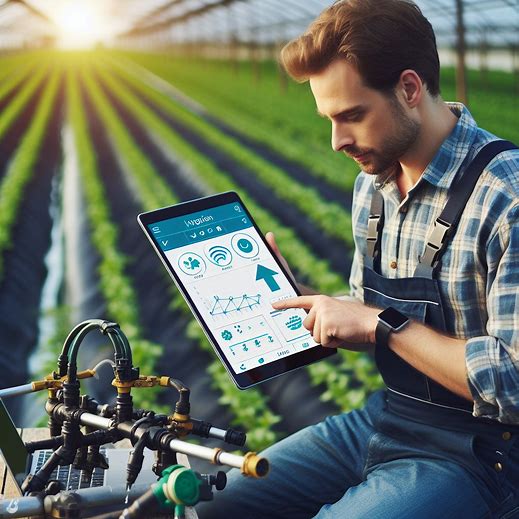Aquaponics farming is a sustainable way of growing food that combines fish farming (aquaculture) and soil-less plant cultivation (hydroponics) in a symbiotic environment. Aquaponics farming can save water, reduce waste, and produce organic and nutritious food. In 2024, aquaponics farming is expected to become more popular and accessible, as more people seek to grow their own food in an eco-friendly and efficient way. In this blog post, we will show you how to start aquaponics farming in 2024, and what are the benefits, challenges, and examples of this method.
What is Aquaponics Farming?
Aquaponics farming is a method of farming that uses a closed-loop system that recycles water and nutrients between fish and plants. The basic principle of aquaponics farming is that fish produce waste, which is converted by bacteria into nutrients for plants, and plants filter and purify the water for fish. This way, both fish and plants benefit from each other, and no external inputs are needed, except for fish feed and electricity.
Aquaponics farming has several advantages over conventional farming methods, such as:
It saves water: Aquaponics farming uses up to 90% less water than traditional farming, as water is constantly recycled and reused in the system.
It reduces waste: Aquaponics farming eliminates the need for chemical fertilizers and pesticides, as fish waste provides natural fertilizer for plants, and plants prevent algae and diseases in fish tanks.
It produces organic and nutritious food: Aquaponics farming produces organic and high-quality food, as fish and plants are grown in a natural and chemical-free environment, and can provide a balanced and healthy diet.
How to Start Aquaponics Farming in 2024?
To start aquaponics farming in 2024, you need to follow some simple steps, such as:
Choose your location and system: You can start aquaponics farming indoors or outdoors, depending on your space, climate, and budget. You can also choose from different types of aquaponics systems, such as media-based, nutrient film technique (NFT), or deep water culture (DWC), depending on your preferences and goals. You can use tools like Aquaponics System Planner or Aquaponics System Design Tool to help you design and build your aquaponics system.
Choose your fish and plants: You can choose from a variety of fish and plants that are suitable for aquaponics farming, depending on your taste, market, and regulations. Some of the most common fish species for aquaponics farming are tilapia, catfish, trout, and carp, while some of the most common plant species are lettuce, kale, basil, tomatoes, and strawberries. You can use tools like Aquaponics Fish and Plant Selector or Aquaponics Crop Guide to help you choose the best fish and plants for your aquaponics system.
Maintain your water quality and balance: You need to monitor and balance your water quality and parameters, such as pH, ammonia, nitrite, nitrate, and dissolved oxygen, to ensure the health and growth of both fish and plants. You can use tools like Aquaponics Water Test Kit or Aquaponics Water Quality Monitor to help you measure and adjust your water quality and parameters.
Harvest and enjoy your food: You can harvest and enjoy your fresh and organic food from your aquaponics system, depending on the growth cycle and yield of your fish and plants. You can also sell or share your food with your community, and promote the benefits of aquaponics farming. You can use tools like Aquaponics Harvest Calendar or Aquaponics Yield Calculator to help you plan and estimate your harvest and yield.
By following these steps, you can start aquaponics farming in 2024, and enjoy the benefits of this method.
What are the Benefits of Aquaponics Farming for You and the Planet?
Aquaponics farming can bring various benefits for you and the planet, such as:
It saves money and resources: Aquaponics farming can help you save money and resources, by reducing your dependence on external inputs, such as water, fertilizer, and land, which can be expensive, scarce, or limited. For example, a study by the University of Arizona found that aquaponics farming can save up to 75% of water and 50% of fertilizer compared to conventional farming.
It increases productivity and quality: Aquaponics farming can help you increase your food productivity and quality, by enhancing your food health, diversity, and security. For example, a study by the University of the Virgin Islands found that aquaponics farming can produce up to 10 times more food per unit area than conventional farming.
It enhances sustainability and responsibility: Aquaponics farming can help you enhance your environmental and social sustainability and responsibility, by reducing your ecological footprint, human health risks, and food waste. For example, a study by the University of Hawaii found that aquaponics farming can reduce greenhouse gas emissions by up to 90% and food waste by up to 80% compared to conventional farming.
Conclusion
Aquaponics farming is a sustainable way of growing food that combines fish farming and soil-less plant cultivation in a symbiotic environment. Aquaponics farming can save water, reduce waste, and produce organic and nutritious food. In 2024, aquaponics farming is expected to become more popular and accessible, as more people seek to grow their own food in an eco-friendly and efficient way. In this blog post, we have shown you how to start aquaponics farming in 2024, and what are the benefits, challenges, and examples of this method. Whether you are a hobbyist or a professional, aquaponics farming can offer you a rewarding and sustainable way of farming. Join us in discovering the wonders of aquaponics farming, where fish and plants coexist in harmony, and create a greener and healthier future for ourselves and the planet.



